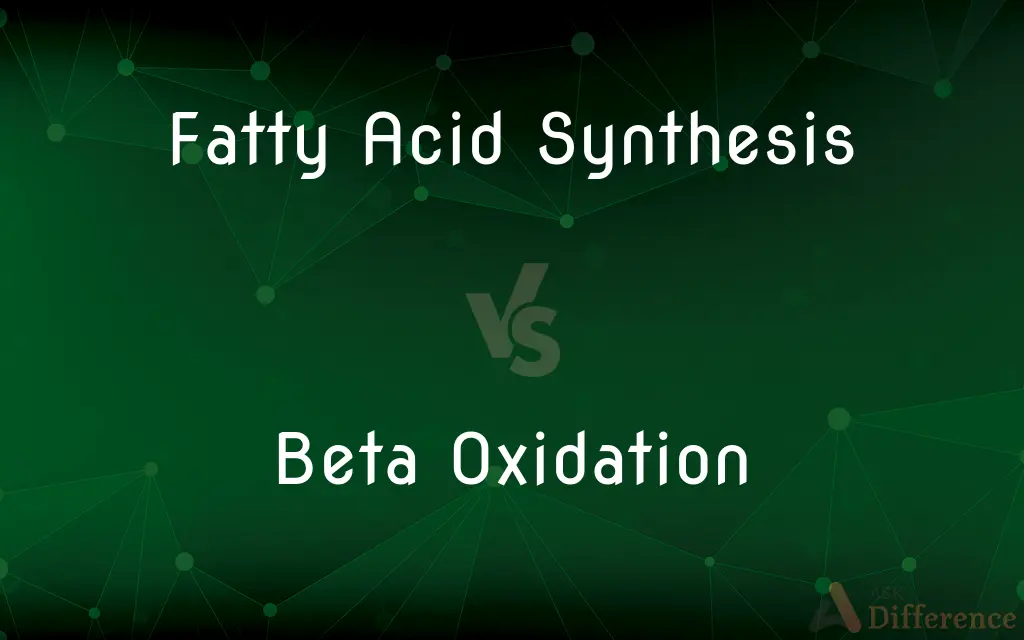Fatty Acid Synthesis vs. Beta Oxidation — What's the Difference?
By Tayyaba Rehman — Published on January 5, 2024
Fatty Acid Synthesis is the metabolic process of creating fatty acids, while Beta Oxidation is the breakdown of fatty acids for energy.

Difference Between Fatty Acid Synthesis and Beta Oxidation
Table of Contents
ADVERTISEMENT
Key Differences
Fatty Acid Synthesis is a biosynthetic process where fatty acids are constructed from acetyl-CoA subunits in the cytoplasm of cells. This process occurs when the body has excess energy, converting carbohydrates or proteins into fatty acids, which are then stored as fat. Beta Oxidation, in contrast, is a catabolic process that breaks down fatty acids within the mitochondria to produce energy. It takes place when the body needs energy, converting stored fat into usable energy in the form of ATP.
The enzymatic steps involved in Fatty Acid Synthesis include the action of acetyl-CoA carboxylase and fatty acid synthase complex, leading to the elongation of the fatty acid chain. Beta Oxidation involves the sequential action of enzymes that remove two-carbon acetyl-CoA units from the carboxyl end of a fatty acid chain. Each cycle of beta oxidation shortens the fatty acid chain and produces FADH2 and NADH, which enter the electron transport chain to generate ATP.
Fatty Acid Synthesis requires energy input, typically in the form of ATP and NADPH, and is regulated by the energy needs of the body. When energy is abundant, the synthesis of fatty acids is promoted. Conversely, Beta Oxidation generates energy and is upregulated during fasting or low-carbohydrate conditions when the body needs to mobilize energy reserves.
The regulation of Fatty Acid Synthesis and Beta Oxidation is tightly controlled and often occurs in response to hormonal signals. Insulin, for example, promotes Fatty Acid Synthesis, while glucagon and epinephrine stimulate Beta Oxidation. This regulation ensures that the body efficiently manages its energy resources, synthesizing fatty acids when excess energy is available and breaking them down when energy is needed.
In summary, Fatty Acid Synthesis and Beta Oxidation are opposite metabolic processes, with one building fatty acids for storage and the other breaking them down for energy. Understanding these pathways is crucial in fields like biochemistry and medicine, particularly in the context of metabolic disorders and energy homeostasis.
ADVERTISEMENT
Comparison Chart
Process Type
Anabolic (building up)
Catabolic (breaking down)
Location in Cell
Cytoplasm
Mitochondria
Energy Requirement
Requires energy (ATP and NADPH)
Produces energy (ATP, FADH2, NADH)
Regulation
Promoted by insulin, inhibited by glucagon
Promoted by glucagon and epinephrine
Function
Stores excess energy as fat
Mobilizes stored fat for energy production
Enzymes Involved
Acetyl-CoA carboxylase, fatty acid synthase
Dehydrogenases, hydratases, thiolases
Compare with Definitions
Fatty Acid Synthesis
This process occurs in the cytoplasm.
Enzymes in the cytoplasm mediate the steps of fatty acid synthesis.
Beta Oxidation
This process occurs in the mitochondria.
Beta Oxidation of fatty acids takes place within the mitochondria of cells.
Fatty Acid Synthesis
Fatty Acid Synthesis is the creation of fatty acids from acetyl-CoA.
During periods of excess caloric intake, fatty acid synthesis occurs to store energy.
Beta Oxidation
Beta Oxidation is the breakdown of fatty acids to produce energy.
During fasting, beta oxidation provides energy by breaking down fat stores.
Fatty Acid Synthesis
It is an energy-consuming process.
ATP and NADPH are used during fatty acid synthesis.
Beta Oxidation
Beta Oxidation involves sequential removal of two-carbon units.
Each round of beta oxidation shortens the fatty acid chain by two carbons.
Fatty Acid Synthesis
Fatty Acid Synthesis is regulated by insulin.
Post-meal insulin release stimulates fatty acid synthesis.
Beta Oxidation
Beta Oxidation is activated during energy deficit.
When glucose levels are low, the body activates beta oxidation for energy.
Fatty Acid Synthesis
Fatty Acid Synthesis involves elongating carbon chains.
Each cycle of fatty acid synthesis adds two carbons to the growing fatty acid chain.
Beta Oxidation
It generates ATP, FADH2, and NADH.
The energy from beta oxidation is captured in the form of ATP, FADH2, and NADH.
Beta Oxidation
The oxidative degradation of saturated fatty acids, occurring in a repeating cycle of steps in which a two-carbon unit is removed from the molecule during each cycle.
Beta Oxidation
(biochemistry) The catabolic process by which fatty acid molecules are broken down in the cytosol in prokaryotes and in the mitochondria in eukaryotes to generate acetyl-CoA, NADH, and FADH₂.
Common Curiosities
Where does beta oxidation occur?
Beta oxidation occurs in the mitochondria.
What triggers fatty acid synthesis?
It's triggered by an excess of energy, particularly after carbohydrate-rich meals.
Where does fatty acid synthesis occur in the cell?
It occurs in the cytoplasm.
How does beta oxidation contribute to energy production?
It breaks down fatty acids to produce ATP, NADH, and FADH2, which are used for energy.
Can fatty acid synthesis lead to weight gain?
Yes, excessive fatty acid synthesis can contribute to fat storage and weight gain.
What is fatty acid synthesis?
It's the metabolic process of creating fatty acids from acetyl-CoA.
What is beta oxidation?
Beta oxidation is the metabolic process of breaking down fatty acids to produce energy.
Is beta oxidation a form of aerobic or anaerobic metabolism?
Beta oxidation is an aerobic process, requiring oxygen.
What are the end products of fatty acid synthesis?
The end products are fatty acids, which can be stored as triglycerides.
When is beta oxidation activated?
It's activated during fasting or low-carb conditions to provide energy.
What role does insulin play in fatty acid synthesis?
Insulin promotes fatty acid synthesis.
What happens to the FADH2 and NADH produced in beta oxidation?
They enter the electron transport chain to produce more ATP.
How does the body regulate fatty acid synthesis?
It's regulated hormonally, mainly by insulin and glucagon.
Can beta oxidation occur with all types of fatty acids?
Yes, but the process varies slightly for different types, like unsaturated fatty acids.
Are there any diseases associated with dysfunctional fatty acid metabolism?
Yes, disorders like fatty liver disease and certain inborn errors of metabolism are linked to dysfunctional fatty acid metabolism.
Share Your Discovery

Previous Comparison
Packages in Java vs. Interfaces in Java
Next Comparison
Radio wave vs. MicrowaveAuthor Spotlight
Written by
Tayyaba RehmanTayyaba Rehman is a distinguished writer, currently serving as a primary contributor to askdifference.com. As a researcher in semantics and etymology, Tayyaba's passion for the complexity of languages and their distinctions has found a perfect home on the platform. Tayyaba delves into the intricacies of language, distinguishing between commonly confused words and phrases, thereby providing clarity for readers worldwide.
















































